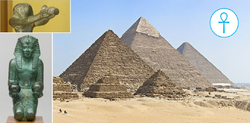- Retour accueil
- Vous êtes ici : Blog The Pyramids of the Cold The Pyramids of the Cold Section 23 • The Sun God Ra Impactor and the Squeaky Hauling Rope
The Pyramids of the Cold Section 23 • The Sun God Ra Impactor and the Squeaky Hauling Rope
Publié par Bruno Coursol dans The Pyramids of the Cold le 15/09/2022 à 06:49
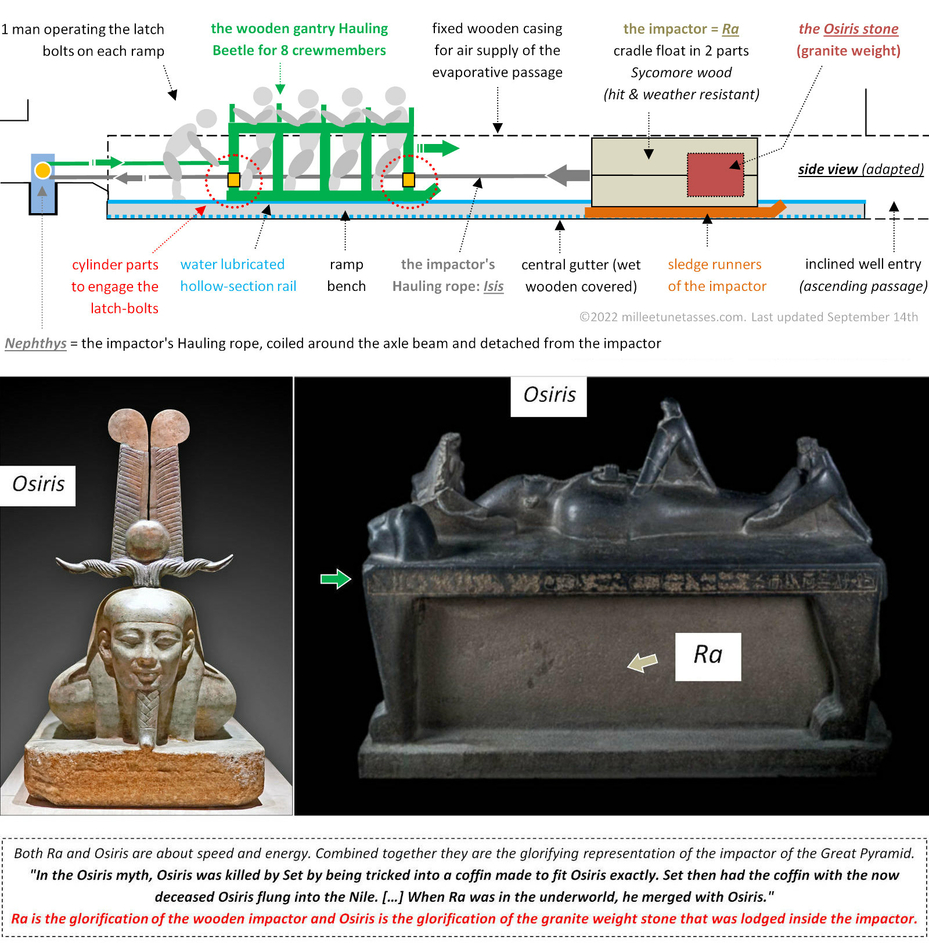
If Sun god Ra was described as the creator of everything in ancient Egyptian religion, it is only because Ra was the metaphoric representation of the piece of equipment that gave life to the Great Pyramid of Egypt: Sun god Ra is the wooden impactor of the inclined well of the pyramid. But because the impactor's weight would be too light if it was only made of wood, a granite stone, that had been glorified into Osiris, was inserted into this wooden float.
These 2 images only seem about Osiris alone, but they are both about Osiris (the stone of the impactor) and Ra (the impactor itself). On the left : Osiris is represented in his "awakening" position which is actually his "high-speed skeleton" position, and Ra is the "sledge". On the right : Osiris is represented in a "dead" position which is actually his "hauled" position; and Ra (the impactor) is right underneath him, in a light-brown color coffin. This light-brown coffin is the impactor, it is a representation of Ra in its original wooden coffin shape.
Also, the "Bed" on which is resting Osiris, is not a real bed : it is the representation of the Hauling Beetle, "floating" over the impactor.
Le réveil d'Osiris (the Awakening of Osiris) at the Exposition Osiris, Institut du Monde Arabe, by Jean-Pierre Dalbéra
'Osiris on his Funeral Bed', Egyptian Museum, Cairo (JE32090); Photo: Christoph Gerigk © Franck Goddio / Hilti Foundation. Saint Louis Art Museum: https://www.slam.org/audio/sunken-cities/
The Pyramids of the Cold Section 23 • The complete operating of the Sun god Ra impactor of the Great Pyramid of Egypt
In summary : the ancient Egyptian myth about Sun god Ra on his barque, endlessly sailing through the Underworld, day after day and fighting the Great Serpent Apep every single night without ever killing him, is nothing less than a metaphorical description of the endless cycle of operating of the impactor of the Great Pyramid of Egypt. During its entire operating period, the impactor was relentlessly ramming into the inclined well waters, to produce pressurized water and evaporative cold production through a fog nozzle.
In the Osiris myth, the trick for its understanding is that there is no Ra sailing on a barque. Ra is the barque. Ra is the impactor of the Great Pyramid.
To be more specific, and because we know that Ra was supposed to "merge" with Osiris in the Underworld, and that it was Osiris who would give to Ra all his force and all his power, Ra is the representation of the wooden coffin of the impactor, and Osiris the representation of the granite stone that was lodged inside that coffin. The Osiris stone was the weight, the ballast stone in which the impactor Ra gained all his power.
If Isis is described as the One who is saving Osiris in the Osiris myth, it is because Isis is representing the Hauling rope of the impactor: she is getting Osiris out of the waters of the well. And if Isis' twin sister Nephthys is described as "below the earth and invisible" when Isis is "above the earth and manifest", it is because Nephthys is that exact same rope, but completely coiled around the axle beam. Isis and Nephthys aren't twin sisters: they are the same thing; they are simply representing the same rope at two different times in its operating cycle.
Isis is the active Hauling rope and Nephthys is the inactive rope fully resting around its axle beam and disconnected with the impactor.
23.01 Sun god Ra isn't about the Sun : he is all about water
The first thing you learn about ancient Egyptians is that they worshiped the sun, and that Ra was the glorification of this sun. Egyptologists are very clear, everything is about the sun, hence Sun god Ra.
What I've discovered is that not only ancient Egyptians didn't care at all about the sun, but that pretty much their entire religion is actually about water; not just plain water, but the water from the Nile which powered up the Great Pyramid.
Ancient Egyptians used the (softened) water from the Nile (Section 18 about the sarcophagus) as a lubricant for the Hauling Beetle and the impactor in the Grand Gallery and as the inclined well waters that got pressurized and created evaporative cold in the horizontal passage.
Ancient Egyptians even described the water cycle between liquid water and evaporated water with the Geb and Nut deities. Everything or almost everything in ancient Egyptian 'religion' is directly or indirectly referring to water.
Ra isn't about the Sun: Ra is (indirectly) about water; Ra is the glorification of the impactor of the inclined well of the Great Pyramid of Giza.
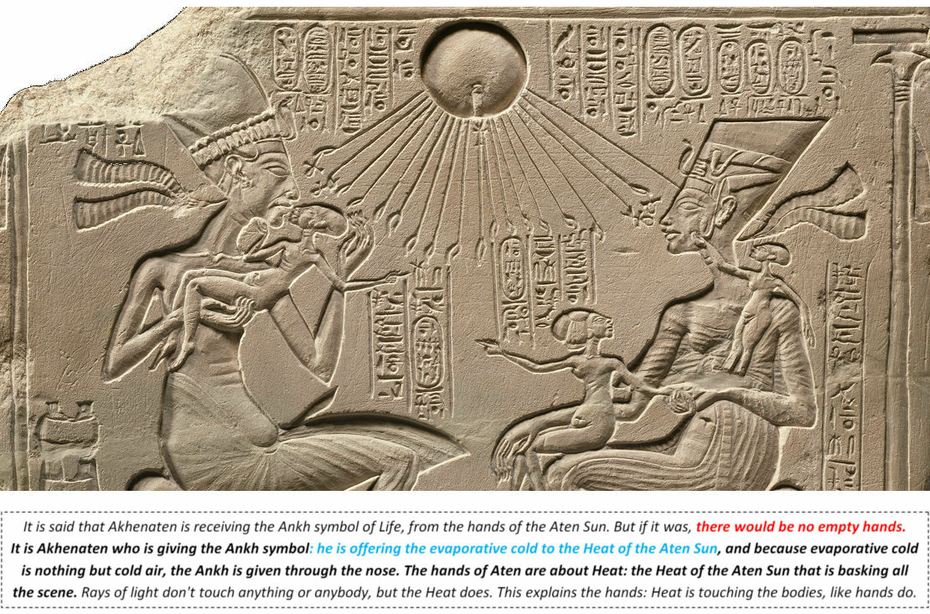
House altar: Akhenaten, Nefertiti and three of their daughters under the Radiant Aton. State Museums in Berlin, Egyptian Museum and Papyrus Collection / Margarete Büsing: https://recherche.smb.museum/detail/607132
23.02 The Heat of Sun god Ra is the reason why ancient Egyptians would have worshipped the Sun
This idea that ancient Egyptians only referred to the sun because of the Heat it is generating is actually well known : "The Eye of Ra also represents the destructive aspect of Ra's power: the heat of the sun" https://en.wikipedia.org/wiki/Eye_of_Ra
The Heat of the Sun, is also what the Akhenaten and Aten scene is all about : the light beams are about Heat, not light.
23.03 The Sun metaphor and the operating cycle of the impactor in and out of the well
I've always wondered why egyptologists were so eager to talk about the sun, and if ancient Egyptian themselves really talked about it or if it was another incorrect interpretation from the early 1800's.
We've seen in the 'Weighing of the Heart' Section 20, that ancient Egyptians couldn't stop talking about the Heart, but only because it was referring to the Heart of the Great Pyramid, the masterpiece of engineering that was the inclined well. The Heart was nothing but another metaphor.
So maybe it is the exact same thing with the Sun : the Sun would be just another metaphor.
23.04 The evaporative cold Ankh symbol is given by Akhenaten to Aten, through the nose : it is about cold air
Actually we've already seen in the Akhenaten Section 17, that the Sun actually really had been one on these metaphors : the Sun is simply representing the Heat. If at the end of every single ray of light there is a hand, it is because it is not about light in the first place : the hands are for touching, and you don't 'feel' the light on your body, but you do feel the warmth of the Sun of your body.
The Aten is just a metaphoric representation of the Heat, and what Akhenaten is giving to the Aten Sun is the Ankh symbol : the symbol for the evaporative cold. Because the evaporative cold is nothing but cold air, Akhenaten is giving the Ankh symbol of the cold, through the nose. The nose is made for the air.
But this is a metaphor from the 18th Dynasty, and from a King who apparently didn't want to worship every single god from the past; Akhenaten wanted to be remembered as the one who created the cold : he wanted to replace the ancient gods so to speak.
So, if ancient Egyptians really were worshipping some kind of Sun god, and in some ways the endless day and night cycles, it could simply come from the endless operating cycle of the impactor.
When the impactor was inside the inclined well waters, ancient Egyptians described it like it was Night; and when the impactor was back in the Grand Gallery, it was Day again.
The retrieving of the floating impactor from the waters of the well would have marked the beginning of a new day in the voyage in the afterlife of the deceased; and the entering in the waters would have marked dusk, the beginning of the night in the afterlife.
"As this deity, Ra confers with Osiris on the deepest of levels, perhaps confirming which souls have been rightly justified before transporting them, and then traveling on through the underworld darkness toward the dawn of paradise. As the barge rolls through the underworld, it is attacked by the serpent Apophis who tries to kill Ra and prevent the sunrise. The gods onboard fight the serpent off with the help of the justified dead while, on earth, the living encourage the defenders through ritual ceremonies, channeling positive energies to strengthen those on board. Every night Apophis attacks, and every night he is defeated. Ra and his crew sail on toward dawn, the justified dead are delivered to their destination, and the sunrise was then seen as the sign that Ra was again victorious, and the Egyptians would see another day."
https://www.worldhistory.org/Ra_%28Egyptian_God%29/
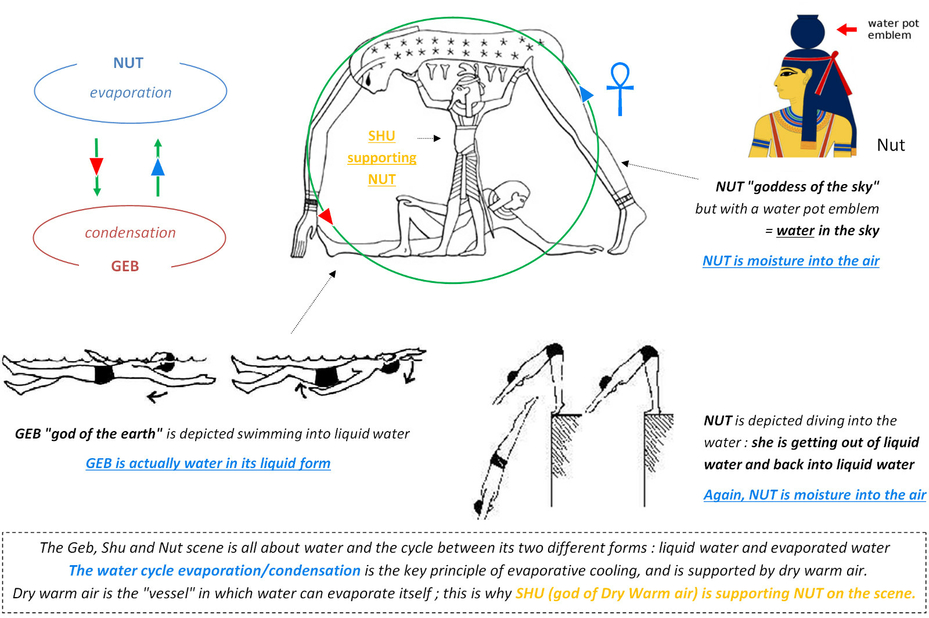
23.05 The scientific metaphoric representations of the ancient Egyptian gods
Every single ancient Egyptian god is only a metaphor, and they all are about a particular aspect of the scientific research program they've started probably with the very first Dynasty. Most of these gods are directly referring to how was created evaporative cold in the horizontal passage and how was this process based on.
For example, gods like Shu, Geb and Tefnut are a perfect representation of the evaporation of water from liquid water, and the fact that this evaporative process was supported by Shu, the god of dry and warm air.
23.06 The impactor ramming into the inclined well waters (Nun) to produce pressurized water (Apep)
I've already talked about the distinction that has to be made between the waters of the well before the pressurization and the pressurized waters strictly speaking.
The 'plain still' waters had been glorified into what have been called the primordial waters of Nun, while the pressurized waters had been represented into the Great Serpent Apep (also Apophis).
This passage talks about how Atum created everything in human form out of the chaos: "At the beginning of time, when there was nothing but chaos, the sun-god existed alone in the watery mass of Nun which filled the universe. "I am Atum when he was alone in Nun, I am Ra when he dawned, when he began to rule that which he had made."
Once the well is pressurized, a small amount of that water is ejected into the horizontal cooling passage, and that is Atum : about 200 liters of pressurized water which every 15 minutes or so passes through the fog nozzle to create a fog of microdroplets of liquid water. This very particular form of water had been glorified into goddess Tefnut (Tef, or 'tf', meaning to spit, Section 5).
"He (Ra) created Shu, god of air, and the goddess of moisture, Tefnut."
The above excerpt is by the way, another confirmation that the purpose of the impactor was not limited to produce pressurized water, just like the "awakening" Osiris figure already have suggested it (previous Section 21).
If Ra is the one creating Shu, the god of dry and warm air, it is because the fall of the impactor is taking place inside a fixed wooden caisson that was perfectly extending the inclined well, probably to the top of the Grand Gallery. https://en.wikipedia.org/wiki/Ra
23.07 The Primeval Hill on which Ra is creating Shu and Tefnut is the Grand Gallery
"On a Primeval hill, Ra created out of himself the first gods, Shu (Dryness and Air), and his partner Tefnut (Humidity), who would engender other gods to complete the Cosmos: Geb the Earth god and Nut the Sky goddess. " https://www.arce.org/resource/ra-creator-god-ancient-egypt
Everyone would have most probably recognized in the "Primeval Hill", the steep slope of the Grand Gallery, precisely where the impactor Ra was operated. More on Nut and Tefnut in Section 3
23.08 Ra as Atum and the Creation process out of Water
Also from Arce : "Before creation, according to Egyptian mythology, only Darkness embraced the Primeval Ocean out of which life would come. When the breath of life was strong and ready, the entity called Atum decided it was time for Creation to begin. An island emerged from the water to support this divinity, who manifested itself in the form of Ra, the sun god of Egypt."
This particular phrase "When the breath of life was strong and ready, the entity called Atum decided it was time for Creation to begin" could be another confirmation that before the well was pressurized, the fall of the impactor first pushed air in front of him. The fixed wooden caisson in which was moving the impactor would have function exactly like a bicycle pump and would have pressurized the evaporative cooling passage with the air of the caisson, before the pressurization of the inclined well waters.
Atum, originating from the well and being the one metaphorical god just before creation could happen, is the "small amount of pressurized water", maybe about 200 liters, that were ejected from the well every 15 minutes or so, towards the fog nozzle.
"Ra was believed to have created all forms of life by calling them into existence by uttering their secret names. In some accounts humans were created from Ra's tears and sweat."
"According to one myth the first portion of Earth came into being when the sun god summoned it out of the watery mass of Nun."
"Ra was thought to travel on the Atet, two solar barques called the Mandjet (the Boat of Millions of Years) or morning-boat and the Mesektet or evening-boat. These boats took him on his journey through the sky and the Duat – twelve hours of night which is also the literal underworld of Egypt. While Ra was on the Mesektet, he was in his ram-headed form." https://en.wikipedia.org/wiki/Ra
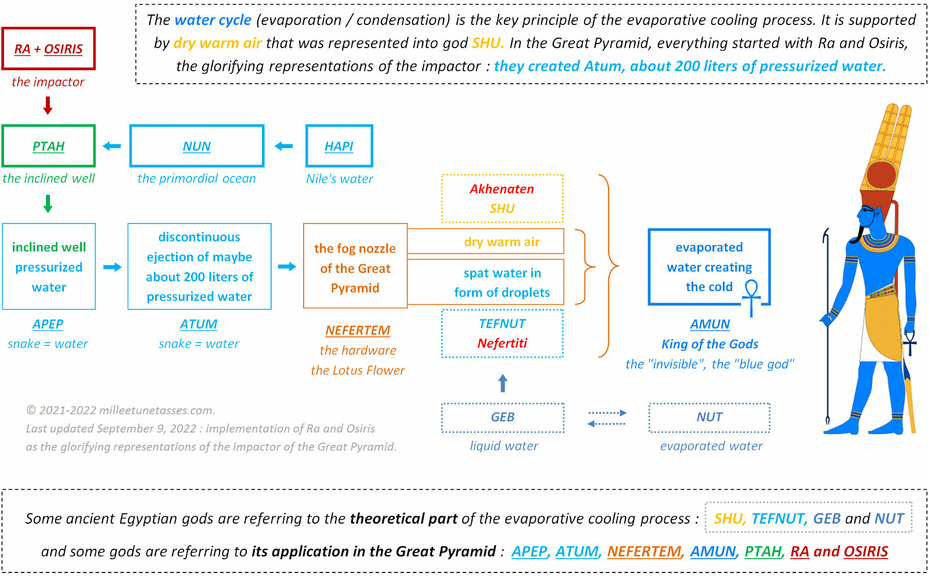
There are genuine links between all ancient Egyptian gods, but they are not about family lineage. Nobody is the grandmother or the mother or the sister of anybody : every single god from ancient Egypt is a metaphor, and nothing else. Most of them were either 'born' with the Great Pyramid (like Taweret and Bes who were referring to the draining of the well, an event which most probably didn't happened before, except in necessary trials), or the pyramid just 'revealed' them, because the Great Pyramid was the outcome of 80 years of technological research (like the gods who are referring to the operating of the Hauling beetle or the impactor which already had to be used before the Great Pyramid in other locations).
23.09 The imbroglio of gods relationships vs. their truly genuine meaning
It will be probably impossible to determine who, between ancient Egyptians themselves of egyptologists from the 19th century, are responsible for the extreme imbroglio regarding all these gods.
But when Nut is described as both Ra's grandmother and mother, and as the goddess of the sky and the stars when her emblem and everything else about her is about water, then it is probably a good indicator that the academic understanding of Nut, as a good example out of many, might be a little off course.
"According to the Pyramid Texts, Ra (as Atum) emerged from the waters of Nun as a benben stone (an obelisk-like pillar). He then spat forth Shu (air) and Tefnut (moisture), and Tefnut in turn gave birth to Geb (earth) and Nut (sky). Ra tried to separate Geb and Nut by placing Shu between them and decreed that Nut could not give birth on any day of the calendar. […]It was thought that Ra “died” or was swallowed by Nut every evening as the sun dipped below the horizon. He travelled through the world of the dead by night and was then reborn in the morning (making Nut both his granddaughter and his mother). At sunset he was linked to Horakhty (Horus on the Horizon) and Atum, and at dawn he was linked to the scarab beetle, Khepri (“the Emerging One”) and Nefertum." https://ancientegyptonline.co.uk/ra/
"Atum-Ra (or Ra-Atum) was another composite deity formed from two completely separate deities; however, Ra shared more similarities with Atum than with Amun. Atum was more closely linked with the sun, and was also a creator god of the Ennead. Both Ra and Atum were regarded as the father of the deities and pharaohs and were widely worshiped. In older myths, Atum was the creator of Tefnut and Shu, and he was born from the ocean Nun." https://en.wikipedia.org/wiki/Ra
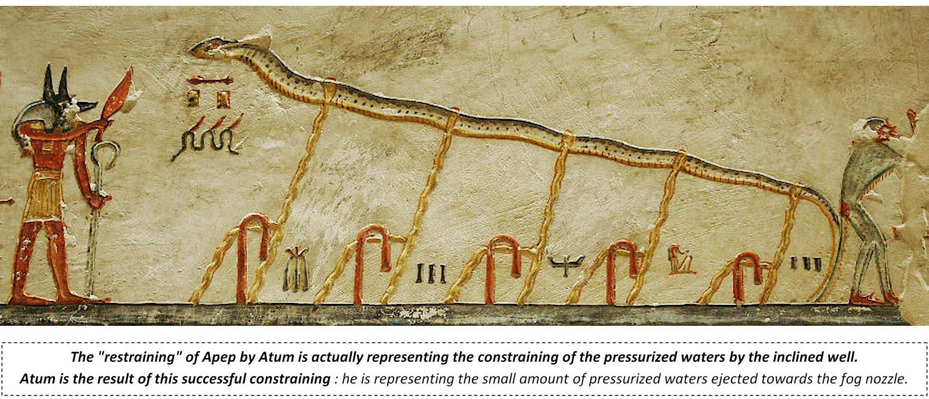
The metaphorical use of the Great Serpent of the Underworld Apep, as a representation of the inclined well pressurized waters, being contained by the girdle stones of the inclined well.
23.10 The snake metaphor for the water used to power up the Great Pyramid
The idea that ancient Egyptians worshiped the Nile river because it fertilized the banks of the river is wrong : they worshiped the Nile because they used its water to power up the Great Pyramid, and every single other site dedicated to science before that.
Even today, almost every significant industrial site is located either next to a major river or directly along sea shore; and the funny thing is that most of the time, the water is used for industrial cooling.
Ancient Egyptians did the exact same thing, and they did it way long before the state of the art Great Pyramid. We know it for sure, because maybe the first metaphor used by Egyptians was the snake metaphor : every single snake representations (in the scientific "religious" context) are about the water from the Nile, and it had been used for a very long time : "The oldest deity known in Egypt was Wadjet, the Egyptian cobra, whose cult never was eclipsed in Ancient Egyptian religion." https://religion.fandom.com/wiki/Isis

Relief from KV 17, the tomb of Sety I. Photograph thanks to kairoinfo4u and posted on flickr
23.11 The Great Serpent Apep is a metaphor of the pressurized waters of the inclined well
The Great Serpent Apep is one of these snake metaphors representing the water from the Nile, and it is about the pressurized waters of the inclined well, being contained by the well: the "restraining of Apep" is the containment of the pressurized waters of the well by the upper girdle gtones.
More on Apep and the Water metaphor in Section 5
In the following excerpt, Ra is linked with Atum and Nut. To understand the real link between them, please look back at the diagram in paragraph 23.08
"Apophis, the god of chaos (isfet), was an enormous serpent who attempted to stop the sun-boat's journey every night by consuming it or by stopping it in its tracks with a hypnotic stare. During the evening, the Egyptians believed that Ra set as Atum or in the form of a ram. The night boat would carry him through the underworld and back towards the east in preparation for his rebirth. These myths of Ra represented the sun rising as the rebirth of the sun by the sky-goddess Nut."
"Apep, also called Apophis, was the god of chaos and Ra's arch-enemy. He was said to lie just below the horizon line, trying to devour Ra as Ra traveled through the underworld." https://en.wikipedia.org/wiki/Ra
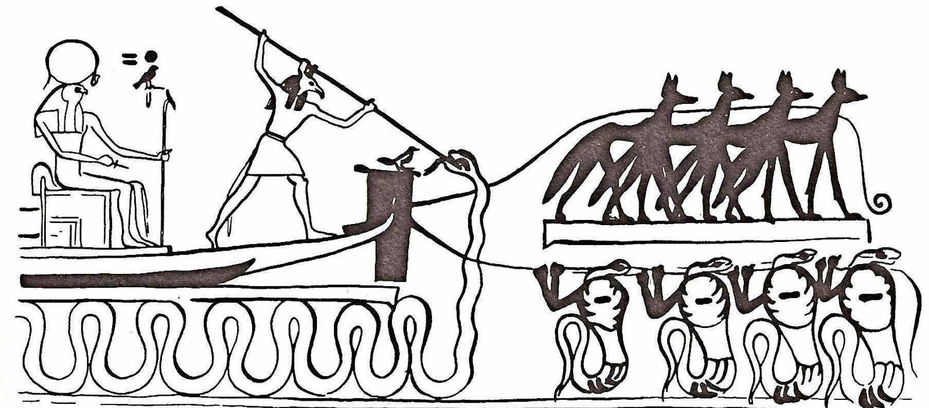
Sun god Ra on his Solar barque with Set fighting Apep, the Great Serpent of the Underworld: https://www.mygodpictures.com/apep-and-seth-imageapep-and-seth-image/
Original image of the draw: "Représentation de la barque solaire de Rê tirée par des chacals et des serpent. L'embarcation est attaquée par le serpent Apophis mais ce dernier est transpercé par Seth". Papyrus funéraire de Hérouben. Soutekh67 on Wikipedia: https://fr.wikipedia.org/wiki/Fichier:Barque_solaire_contre_Apopi.jpg
23.12 The Osiris myth is about the "killing" of the Great Serpent Apep: it is about the power over water
We've seen that snakes were only representations of the water used to power up the Great Pyramid, so when Ra and the Great Serpent Apep are fighting against each other in the Underworld, it means that Ra is actually "fighting" with water in the pyramid. The whole Osiris myth is actually based on the operating of the Great Pyramid and the endless cycle of Hauling the Beetle gantry to the top of the Grand Gallery and it release into the steep slope to pressurize the inclined well waters.
23.13 Ra and Osiris had to merge together in the Underworld to accomplish their task
I was talking about the impactor, over and over again for about a year and a half now, and it was right under my nose since the very beginning : just like I've missed Osiris, I've also missed Ra. Of course, I've already understood that Ra's barque, the Solar boat, was the glorification of the impactor (Section 11, 'The Hauling Cavern of the Underworld') but I couldn't figure out what exactly was Ra representing; it could have been anything, but I think I got confused by the academic vision of Ra, and particularly about his Solar barque; because there is not such a thing as Ra's Solar barque. Ra is the barque; Ra is the vessel that is carrying the Osiris stone through the Underworld. Ra is the impactor of the Great Pyramid.
One thing we know about Ra, is that "When Ra was in the underworld, he merged with Osiris..." and because we already know that the Underworld is the internal layout of the Great Pyramid and that Osiris is the granite stone that was inside the impactor, it means that Ra is the wooden impactor itself.
"Throughout the day, Ra sailed across the sky in his barge and then descended down into the underworld at night. The sun barge now transformed into the evening barge known as the Ship of a Million Souls which picked up the newly arrived and justified dead to bring them to the paradise of the Field of Reeds. Ra at this time becomes merged with Osiris, the judge of the dead, and Osiris is seen as the “corpse” and Ra as the “soul” of the single deity Ra-Osiris."
"As this deity, Ra confers with Osiris on the deepest of levels, perhaps confirming which souls have been rightly justified before transporting them, and then traveling on through the underworld darkness toward the dawn of paradise. As the barge rolls through the underworld, it is attacked by the serpent Apophis who tries to kill Ra and prevent the sunrise. The gods onboard fight the serpent off with the help of the justified dead while, on earth, the living encourage the defenders through ritual ceremonies, channeling positive energies to strengthen those on board. Every night Apophis attacks, and every night he is defeated. Ra and his crew sail on toward dawn, the justified dead are delivered to their destination, and the sunrise was then seen as the sign that Ra was again victorious, and the Egyptians would see another day." https://www.worldhistory.org/Ra_(Egyptian_God)/
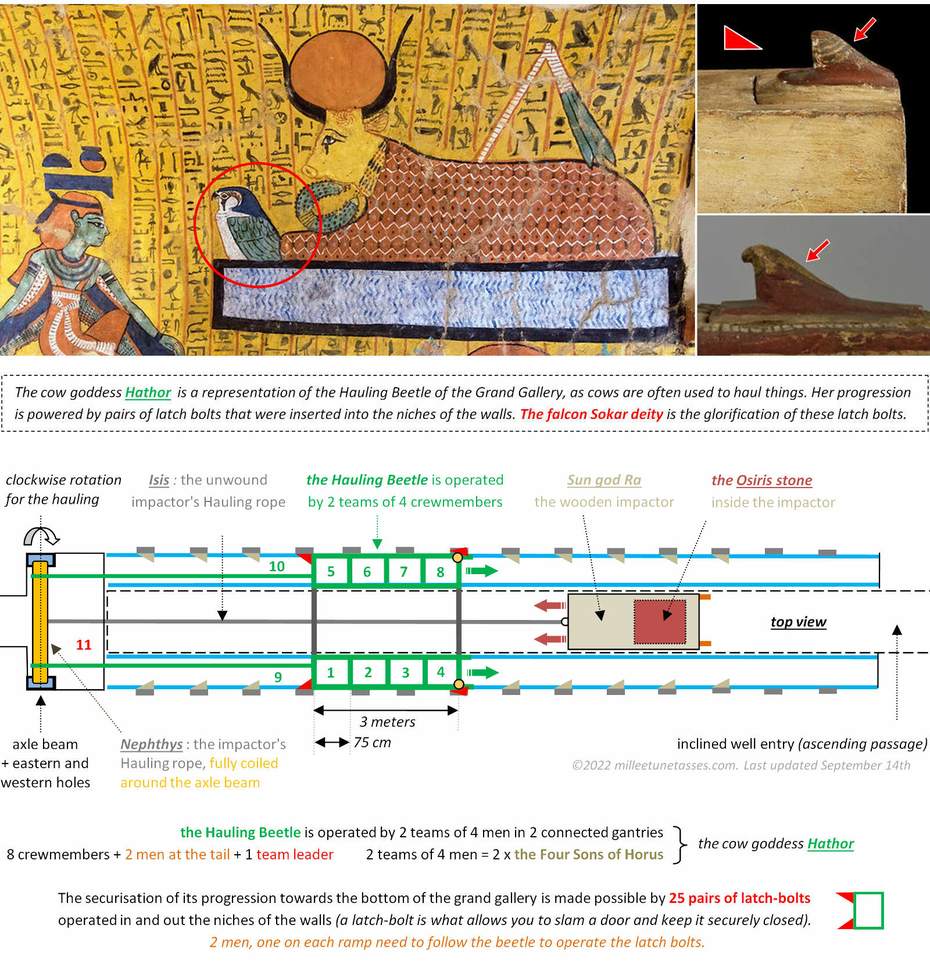
Sun god Ra and Osiris are both glorifying representations of the two parts that constituted the impactor of the Great Pyramid of Egypt.
23.14 Ra is the impactor vessel for the Osiris granite stone
We've seen that in the ancient Egyptian religion, everything is nothing but metaphors and the Underworld isn't different; it is absolutely not just a metaphysical idea : the Underworld is very real, it is the glorification of the internal layout of the Great Pyramid. The King's chamber, the Grand Gallery, the inclined well, the evaporative cooling passage and the Queen's chamber, they all together constitute the ancient Egyptian Underworld.
One particular phrase from the last excerpt is exceptional, and is explaining the role of both deities in the single deity Ra-Osiris: "Ra at this times becomes merged with Osiris, the judge of the dead, and Osiris is seen as the "corpse" and Ra as the "soul" of the single deity Ra-Osiris."
This phrase can be easily understood simply by replacing the term "soul" by "vessel". Ra is the vessel for the "corpse" of Osiris. Translated, it means that Osiris is the one who has to be moved, by using the Ra "vessel".
Ra is the wooden "vessel" impactor for the Osiris granite stone.

Exceptional 3D Model of the "Osiris Death Bed" from Abydos, courtesy of danderson4 on Sketchfab.
"The god Osiris lying on his death and resurrection bed. Discovered by Amélineau in the late 19th century in the tomb of First Dynasty Pharaoh Djer in the royal cemetery at Abydos known as Umm el-Qa’ab. This tomb while originally dated to the First Dynasty, later becomes attributed as the tomb of Osiris. It has been suggested that the sculpture was added to the tomb in the late Middle Kingdom / Second Intermediate Period.
The artifact is of black basalt and represents the god Osiris mummified and wearing the White Crown of Upper Egypt, lying upon a lion headed bed. At the head and feet Osiris is protected by four falcons representing his son Horus and perched above him is the goddess Isis depicted as a Kite.
Photographed when the artifact was in the exhibit “Egypt’s Sunken Cities” at the Minneapolis Institute of Art, November 10, 2018." https://sketchfab.com/3d-models/osiris-death-bed-from-abydos-cdeee4ba154e420b8221dcc56752ae3d
23.15 The Death Bed of Osiris and the eight front finger paws
Because the "Bed of Osiris" is actually a representation of the Hauling beetle of the Great Pyramid, and because this wooden gantry was the assembly of two "half-beetles", one on the eastern ramp and the other on the western ramp, the front paws of the Bed are doubled: the left paw of the Lion have eight fingers and the right paw have eight fingers as well. There are even separating lines on the legs.
Remarkably, these eight finger paws are beautifully echoing the eight crewmembers of the Beetle.
Male Lion Paw, by Jonathan Griffiths: https://www.flickr.com/photos/37047946@N07/3469978681/
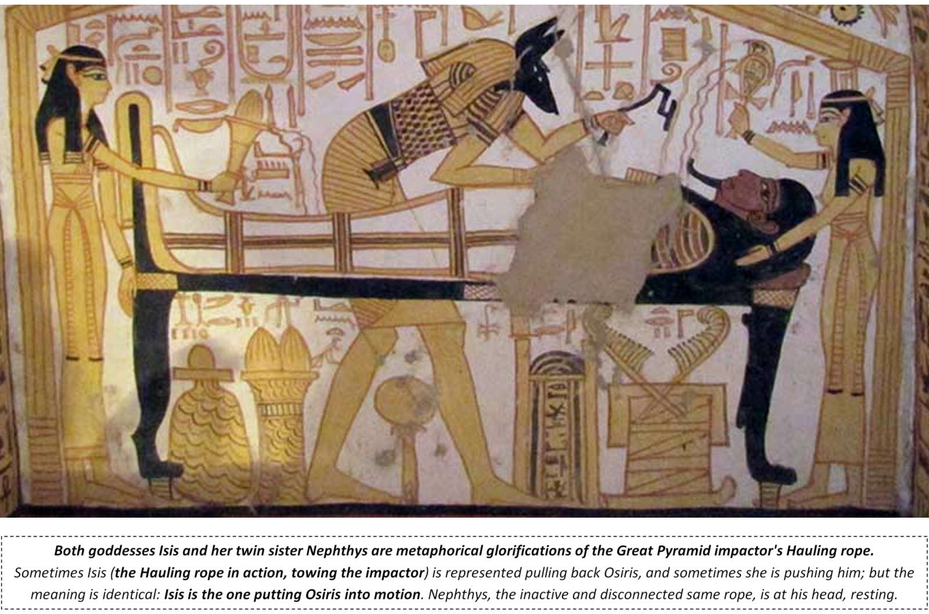
Isis, left, and Nephthys stand by as Anubis embalms the deceased, in the Theban Tomb 335 (Nakhtamun), thirteenth century BCE. By ShillukinUSA: https://en.wikipedia.org/wiki/Isis#/media/File:ThebanTomb335.png
23.16 Isis and Nephthys are the Ones saving both Ra and Osiris from the Great Serpent Apep
We've already seen that the Sokar deity was representing the latch bolts of the Grand Gallery that enabled the sequential hauling of the impactor, one step at a time; and we've also seen that Aker represented both the axle beam and its holders (Section 11); but there is even more to find out about the operating of the impactor : Isis and Nephthys were the representation of the impactor's Hauling rope.
In the Osiris myth, these two goddesses are the ones saving Osiris from the Great Serpent Apep; it means that they are the ones who are getting Osiris out of the waters of the inclined well. Of course, the myth is only mentioning Osiris, because in the single Ra-Osiris deity, Ra was only considered as the "soul", while Osiris was the "corpse".
Isis and Nephthys actually gave life back to both of them, Ra (the wooden impactor) and Osiris (the granite stone).
"It is Nephthys who assists Isis in gathering and mourning the dismembered portions of the body of Osiris after his murder by the envious Set. Nephthys also serves as the nursemaid and watchful guardian of the infant Horus." https://en.wikipedia.org/wiki/Nephthys
"Nephthys or Nebet-Het in ancient Egyptian was a goddess in ancient Egyptian religion. A member of the Great Ennead of Heliopolis in Egyptian mythology, she was a daughter of Nut and Geb. Nephthys was typically paired with her sister Isis in funerary rites because of their role as protectors of the mummy and the god Osiris and as the sister-wife of Set." https://en.wikipedia.org/wiki/Nephthys
If Isis is described as the wife of Osiris, the one who at the very end of the myth is giving life back to him, and if there are many sexual metaphors about Isis and Osiris copulating, it is because, as the metaphorical representation of the central rope (the impactor's Hauling rope); Isis and Osiris were constantly uncoupled (for the release of the impactor) and reassembled (to get the impactor back to the top of the Gallery).
"Isis, who is Osiris's wife as well as his sister, is his queen. Set kills Osiris and, in several versions of the story, dismembers his corpse. Isis and Nephthys, along with other deities such as Anubis, search for the pieces of their brother's body and reassemble it. […] Finally, Isis restores breath and life to Osiris's body and copulates with him." https://en.wikipedia.org/wiki/Isis
In the next paragraphs, we'll see why both twin sisters Isis and Nephthys were actually one single deity representing the impactor's Hauling rope, and why on the above image from Nakhtamun Theban tomb 335, Isis is at Osiris' feet and obviously pushing the Osiris' Bed, while Nephthys is standing still at Osiris' head.
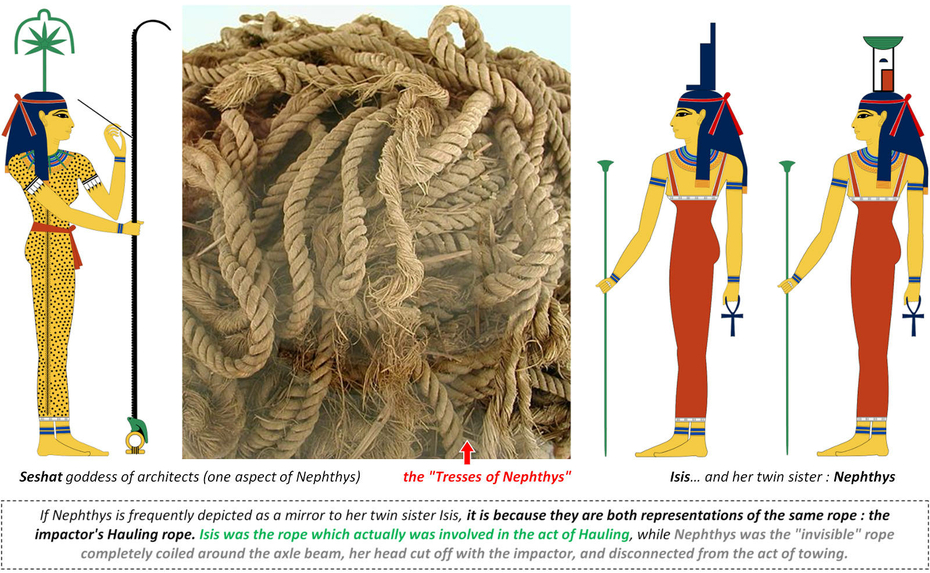
The twin sister goddesses Isis on the left, and Nephthys on the right. Draws by Jeff Dahl on Wikipedia.
Original ropes discovered in the Kheops Solar boat pit. Photograph by Jon Bodsworth: https://en.wikipedia.org/wiki/Khufu_ship
23.17 One of the names of Nephthys is Seshat
The question now is to know what these twin sisters are really representing, and it is Nephthys who is giving the answer, because she is all about ropes.
Most of the time, Nephthys and Seshat are considered two different deities, but this is incorrect: Seshat is only one particular aspect of Nephthys. Seshat is one of the names of Nephthys:
"As early as the Pyramid Texts (the oldest ones date from 2400-2300 BCE), Nephthys is said to have “collected all your members for you in this Her name of Seshat, Lady of Builders.” (Pyramid Texts, Utterance 364)": https://isiopolis.com/2014/07/13/oh-yes-more-nephthys/
"In utterance 364, Nephthys, identified with Seshat, “Lady of Builders,” has collected the limbs of Osiris/the deceased": https://henadology.wordpress.com/theology/netjeru/nephthys/
"Nephthys has been treated here in some detail, foe Seshat proves to have been one of her forms. The Pyramid Texts, par.616, speak of Nephthys 'in this her name of Seshat, Mistress of Builders', and the late inscriptions again record Seshat as a form of Nephthys". Source Sage journals at https://journals.sagepub.com/doi/abs/10.1177/030751334002600105?journalCode=egaa
23.18 Seshat (and her "stretching the cord" ceremony) and Nephthys (and her "Tresses") are about ropes
Probably a good interpretation of the couple constituted of Nephthys and Seshat, would be to identify Nephthys as the 'mythological' aspect of what was really represented into Seshat: the ropes.
"As Lady of Builders, one of Seshat’s main functions is to lay out the boundaries for new buildings, especially temples, via the ceremony of “stretching the cord,” which was a method of using a cord or rope to measure out straight foundations for a building." https://isiopolis.com/2014/07/13/oh-yes-more-nephthys/
This "stretching the cord" ceremony of Seshat, echoes one of the most famous attributes of Nephthys: her "tresses".
The "tresses of Nephthys" are the ropes used by her own Seshat "technical" aspect of herself.
23.19 Isis is the impactor's Hauling rope getting Osiris out of the waters of the well
The reason why both Isis and Nephthys are holding a Wadj scepter representing the stem of papyrus, from which ancient ropes were made of, is because they are both representations of ropes; and because Nephthys was the twin sister or Isis, it also means that Isis is representing a rope.
And it makes perfect sense: if Isis is the One who is giving life back to Osiris and to the impactor Ra, by getting them both out of the inclined well waters, it is because Isis is the impactor's Hauling rope.
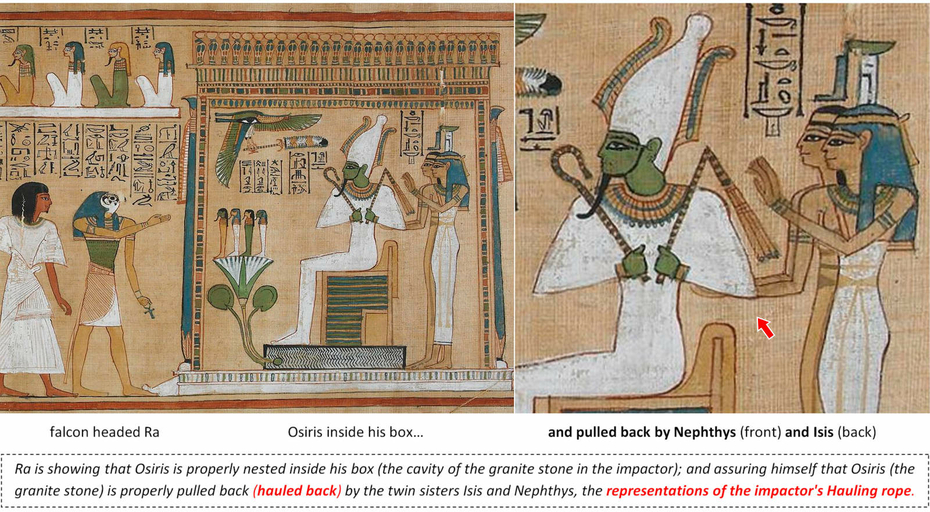
Book of the Dead of Hunefer (Hw-nfr) frame 3, at the British Museum: https://www.britishmuseum.org/collection/object/Y_EA9901-3
23.20 The Nephthys mystery: which rope(s) is she referring to?
I first thought that Nephthys, the twin sister of Isis, was representing the two other ropes of the Grand Gallery: the ones directly connecting the Hauling beetle with the axle beam. At first glance, it looked satisfying. But actually, nothing about Nephthys is supporting this idea. Everything about her is so mysterious:
"When in a dyad with Isis, Nephthys is decidedly the “darker” one. The Pyramid Texts advise the king to “descend with Nephthys” in the Barque of the Night, but arise with Isis in the Barque of the Day."
"Later he says that Nephthys is what is “below the earth and invisible” in contrast with Isis Who “is above the earth and manifest.”
"The one being reborn is to “throw off the tresses of Nephthys” like he throws off his mummy wrappings at his rebirth".
https://isiopolis.com/2014/07/13/oh-yes-more-nephthys/
I really tried to make Nephthys the representation of these two lateral Beetle's Hauling ropes, but in vain. And suddenly, I got it: like the Barque of Ra, which is simply Ra himself; there is no such thing as Isis and her twin sister Nephthys: they are both representing the same thing, they are both about the same rope.
Isis and Nephthys are both glorifying representations of the impactor's Hauling rope, and the difference between the two of them, is that they are not representing the rope in the same moment in its operating cycle.
Because we know that Isis is saving Osiris, meaning she is getting the impactor out of the well, it is pretty easy to understand her : Isis is the typical representation of a Hauling rope that anybody could imagine.
In the following excerpt, Isis is even described "travelling among humans". This phrase looks pretty insignificant, but it is not : because Isis was the impactor's Hauling rope that was set into the central gutter of the Gallery, Isis was indeed literally "travelling" among the crewmembers of the Hauling Beetle.
"In some texts, Isis travels among humans and must seek their help". https://en.wikipedia.org/wiki/Isis
23.21 Isis and Nephthys are the same impactor's Hauling rope: the active one; and the inactive one, coiled around the axle beam
The problem is with Nephthys. When Isis is described as "above the earth and manifest", Nephthys is described as "invisible".
"Later he says that Nephthys is what is “below the earth and invisible” in contrast with Isis Who “is above the earth and manifest.” https://isiopolis.com/2014/07/13/oh-yes-more-nephthys/
There is even this following excerpt that I find so interesting: "The one being reborn is to “throw off the tresses of Nephthys” like he throws off his mummy wrappings at his rebirth".
"The one being reborn is to “throw off the tresses of Nephthys” is actually price less, because it is talking about throwing off the rope so that one can reborn.
Once the impactor has been hauled to the top of the Gallery, I've suggested that it would have been disconnected with its rope before being released into the steep slope. At that exact moment, the Isis Hauling rope is completely wound around the axle beam, and then they had to disconnect the rope with the impactor.
23.22 Beheaded Isis and the release of the impactor, freed from the Hauling rope
Another way of saying that, is that they had to cut off Isis' head: "Isis continues to assist her son when he challenges Set to claim the kingship that Set has usurped […] as when Horus beheads Isis and she replaces her original head with that of a cow—an origin myth explaining the cow-horn headdress that Isis wears". https://en.wikipedia.org/wiki/Isis
It is also mentioned that the original head of Isis is replaced with the head of a cow, and it is directly referring to the act of towing itself : the cow is suggesting the towing (Hathor herself, as a representation of the Hauling beetle, is depicted into a cow goddess).

"Mooring lines are used when arriving or leaving a berth. One of the most important competent crew skills is to know how to handle and tie mooring lines securely and safely": https://www.safe-skipper.com/competent-crew-skills-mooring-lines/
Supply ratings handling a coil of 16 inches (410 mm) towing hawser (rope) at the Royal Navy's Naval Stores Department, Nore, Harwich. Royal Navy official photographer, Russell, J E (Lt) - This is photograph A 16341 from the collections of the Imperial War Museums: https://en.wikipedia.org/wiki/Hawser
23.23 The squeaky mooring lines metaphor of the so famous "Lamentations of Isis and Nephthys"
Everything about the Osiris' festival is about the recreation of the operating of the Grand Gallery, and maybe the most important part of it is the famous "Lamentations of Isis and Nephthys".
Here, on the coast of Brittany France, boats are everywhere and most of the time moored at quayside, with the mooring ropes making all kind of sounds because of the high winds. Some people can say they are just squeaky and creaky dock lines, but others would say they are singing!
The "Lamentations of Isis and Nephthys" are simply, but beautifully reproducing the squeaky mooring sounds of the Isis impactor's Hauling rope. How's that for beautiful!
"she (Nephthys) certainly figured as a goddess of great importance in the annual rites conducted, wherein two chosen females or priestesses played the roles of Isis and Nephthys and performed the elaborate "Lamentations of Isis and Nephthys".
"Her magical skills were similar to those of Isis and some scholars see her as Isis' mirror image, Nephthys' darkness balancing Isis' light, and they are frequently pictured together as twin sisters. In the city of Heliopolis Nephthys and Isis were represented by two virgin priestesses at festivals who would recite the famous Lamentations of Isis and Nepthys at the Osiris' festival. The Lamentations is a long narrative poem recreating the moment Isis and Nephthys worked together to revive the god Osiris and bring him back to life. Her symbols are the hawk and the temple and the sycamore tree, one of the more popular trees depicted in inscriptions from the Egyptian Book of the Dead. Prayers were offered to Nephthys at twilight for protection and also to aid her as she struggled with her husband Set to defend the Boat of Ra (the sun god) from the serpent Apophis as it made its journey through the realms of night." https://www.worldhistory.org/Nephthys/
23.24 The multi-strand rope deterioration due to the squeaking internal friction
For someone who never had to sleep on a small boat moored at the quayside, the squeaking and creaking noises caused by multi-strands ropes could be easily seen as quite meaningless: everybody likes to have a walk along quayside. But if you do want to sleep on the boats, you will quickly change your mind: there is nothing more annoying that these squeaky noises.
But more important, these noises are also a sign that the ropes are deteriorating, from the inside; and this is maybe the reason why ancient Egyptians were so concerned about these noises, and the reason of the Isis and Nephthys Lamentations.
"The "squeak" frequently comes from the strands of line rubbing against one another as they stretch and retract. The process generates internal friction that heats the line up, causes the strands to expand slightly, increases the friction, etc. etc. etc. Several research studies that line failures are frequently caused by internal heating rather than chafe, particularly when lines are run through plastic tubing that prevents water getting to the line and acting as a coolant."
Post by svHyLyte, at: https://www.sailnet.com/threads/squeaking-and-creaking-of-docklines-and-fenders.46595/
23.25 Isis is indeed also known as the "Great Mooring Post"
The fact is that this "mooring" metaphor about Isis, is actually perfectly documented in ancient Egyptian literature: "Isis is not just about rebirth and sunrise. She is also the Great Mooring Post". https://isiopolis12.rssing.com/chan-10218340/all_p4.html
Also, a very detailed study "When Isis "Moored" Osiris", by L. D. Graham - JEOL. Excerpt: "The present paper, which is philological in nature, addresses a central event in the Osiris myth as it is narrated in the Great Hymn on the Stele of Amenmose. Specifically, the Great Hymn says (in line 15) that, when Isis eventually located Osiris’s body after his murder by Seth, she “moored her brother”. https://hcommons.org/deposits/objects/hc:47012/datastreams/CONTENT/content
If you want to have an idea of how the "Lamentations of Isis and Nephthys" sounded like, please listen to this short YouTube video : https://www.youtube.com/watch?v=ehVjrNqfVvc

Tape measure, by William Warby on flickr: https://www.flickr.com/photos/wwarby/4915969081
How a tape measure works: Why it is retractable? by Mift H: https://www.fullyinstrumented.com/how-a-tape-measure-works/
23.26 The Seshat/Nephthys ancient Egyptian goddess of architects… and the modern Self-Retracting Tape Measure
Once in a while throughout my study about ancient Egypt, I stumble upon a little jewel that I particularly enjoy; and there is one right there with the Nephthys glorification of the impactor's Hauling rope completely coiled around the axle beam.
Nowadays, if anyone on earth would have to metaphorically describe one more time everything that happened in the Great Pyramid, like ancient Egyptians did 4500 years ago, I doubt that a deity would be created to represent the impactor's rope, not Hauling anything, simply resting on her axle beam. I'm sure it would be completely disregarded.
Egyptians didn't, and they even used this particular aspect of the operating cycle to create what is still today the emblem of any architect in the world: a measuring tape!
In some way, we can even go further into the metaphor, because if you really think it through, the functioning of the axle beam/impactor's Hauling rope unit, was a perfect match with a very modern self-retracting tape measure.
In modern tape measures, it is the spring mechanism that is retracting the tape; in the Great Pyramid, it was the Hauling beetle that was retracting the impactor's rope and the latch bolts that were having the role of the modern lock button of the tape.
"How a tape measure works are basically not rocket science. It only depends on its two major features: lock and spring mechanism. The lock button behaves to stop the tape from retracting when you extend it. The spring mechanism plays as the automatic roller to retract the tape." https://www.fullyinstrumented.com/how-a-tape-measure-works/
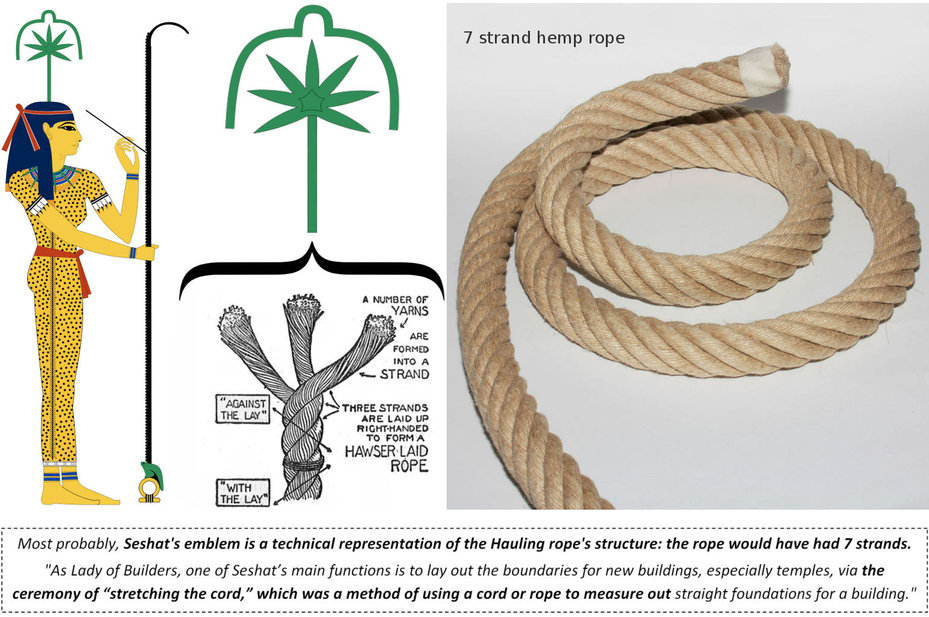
Technical draw of a rope: https://en.wikipedia.org/wiki/Rope
Seven strand hemp rope: https://www.corderie-lorenzi.fr/en/elementor-3554/
23.27 The seven strand structure of the impactor's Hauling rope
Most probably, Seshat's emblem is a technical representation of the Hauling rope's structure: the rope would have had 7 strands.
The curious shape on top of the 7-pointed green emblem would be how ancient Egyptians have drawn our modern curly brackets: they are explaining that the 7 strands were combined to form one single rope.
"As Lady of Builders, one of Seshat’s main functions is to lay out the boundaries for new buildings, especially temples, via the ceremony of “stretching the cord,” which was a method of using a cord or rope to measure out straight foundations for a building." https://isiopolis.com/2014/07/13/oh-yes-more-nephthys/
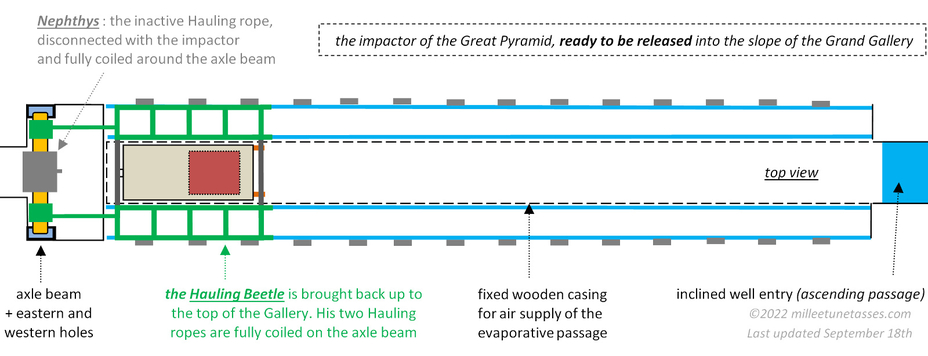
The impactor of the Great Pyramid, ready to be released into the slope of the Grand Gallery. Of course, the impactor is not really visible like shown on the draw: the impactor is hidden inside the fixed wooden caisson.
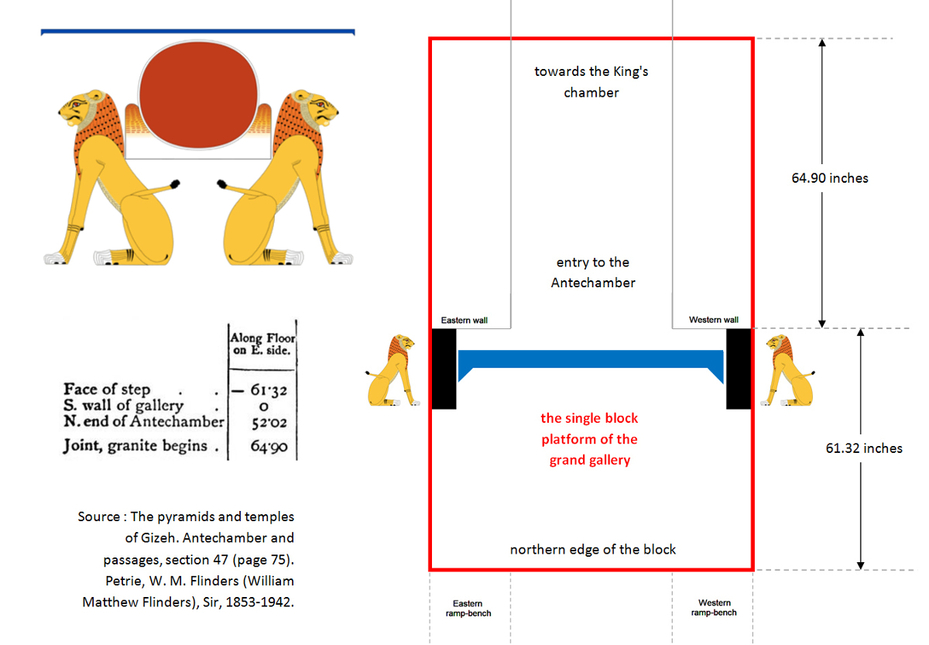
The top platform of the Grand Gallery has a very specific design, because it is actually made of one single giant block that goes way after the south wall of the gallery towards the antechamber: the block is way bigger than what we can see of it, exactly like it is for the girdle stones of the inclined well.
The southern part of the block was under tremendous charge, due to the enormous above structure weight, that perfectly anchored the block. This particular design was necessary to resist the huge structural stress induced by the endless operating of both the Hauling beetle and the impactor.
Charles Rigano mentioned : "The single block forming the Step does not stop at the Gallery wall but extends an additional 66 inches* into the Ante Chamber".
* For Petrie, it was 64.90 inches. Source : The pyramids and temples of Gizeh. Antechamber and passages, section 47 (page 75). Petrie, W. M. Flinders (William Matthew Flinders), Sir, 1853-1942. https://archive.org/details/cu31924012038927/page/n113/mode/2up
23.28 Aker is the glorification of the axle beam, the one who "bends and imprisons the coils of the snake"
It is known that the name Aker means "(one) who bends", and it is conceivable to imagine that the axle beam would indeed bend a lot. We've already seen that the beam was most probably made of Tamarix wood which is very resistant to tension.
That reference to the bending of Aker is easy to apprehend, and probably the reference to the imprisoned coils of the snake is simply referring to the winding of the ropes on the axle beam.
"More importantly, he imprisons the coils of the snake, Apophis (Apep), after it is hacked to pieces by Isis, and Aker could, along his back, provide a secure passage for the sun-god's boat as it traveled from west to east during the hours of the night." http://www.touregypt.net/godsofegypt/aker.htm
"The name Aker means '(one) who bends'". https://ancientegyptonline.co.uk/aker/
God Aker (Akeru, plural), drawing by Jeff Dahl : https://fr.wikipedia.org/wiki/Aker#/media/Fichier:Aker.svg
23.29 The "grasp of the Akeru" and the hazardous work reference about the winding of the ropes
Until now, we haven't discussed at all about the danger that were facing the crewmembers of the wooden beetle scarab. When they were inside the gantry, they most probably didn't risk anything : their work would have been excruciating but not that dangerous.
I suggested the idea that when the impactor was at the top of the gallery, ready to be released in the slope, the crewmembers first had to get the wooden gantry lifted back up as well, so that the entire crew would most probably be on the top platform just before releasing the impactor.
I also suggested that one crewmember on each ramp was on the top platform, hauling the ropes of the gantry while the 4 other crewmen, on each ramp, were pushing the beetle back up.
During these two phases of operating, crewmen would have been close to the axle beam while the ropes would have been winded on, and they would certainly have fear the danger of their hands being grasped by the ropes winding on the axle :
"Later the Egyptian priests created magical spells to protect ordinary mortals from the grasp of the Akeru, the primeval, lion earth gods." https://www.landofpyramids.org/aker.htm
"There was also a more threatening side to Aker that can be seen when he is pluralized as Akeru in the form of multiple earth gods. In passages from the Pyramid Texts, the Akeru are said not to seize the monarch, but later there is a general hope for everyone to escape the grasp of the earth gods." http://www.touregypt.net/godsofegypt/aker.htm
More on Aker, in Section 11 "The Hidden Hauling Cavern of the Underworld"
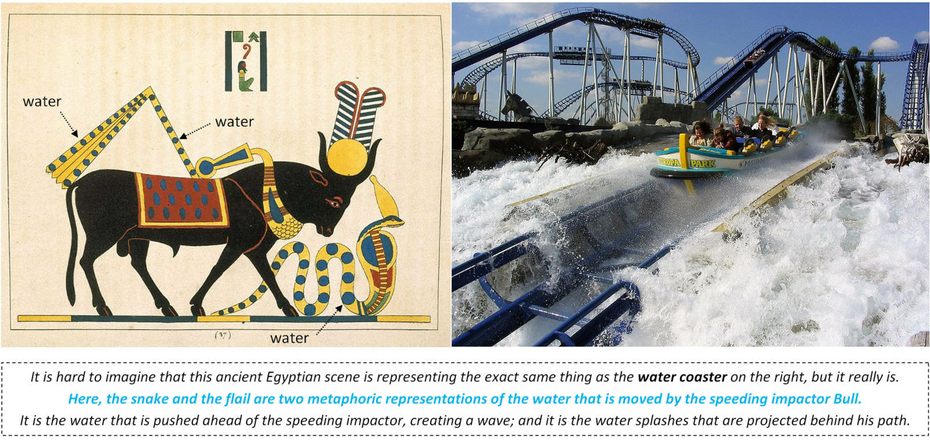
Api or Hapi (Apis, Taureau Consacré a la Lune)", 1823-25, by the French illustrator Léon-Jean-Joseph Dubois, at the Brooklyn Museum: https://www.brooklynmuseum.org/opencollection/archives/image/55326
"Poseidon" water coaster at Europa-Park, by Stefan Scheer: https://en.wikipedia.org/wiki/Water_ride#/media/File:Europapark_Poseidon.jpg
23.30 The Apis Bull is a representation of the impactor speeding in the Grand Gallery
I've been confused a long time about cows and bulls' meaning in the ancient Egyptian religion, probably because both have horns, and I associated them both with the ramming impactor.
But they are really different, even if they are complementary : while Bulls are about the power of the impactor, cows are about the power of the hauling.
Maybe the most beautiful representation of the impactor Bull I know of, is the one on the above image by the French illustrator Léon-Jean-Joseph Dubois. I'm sure the scene looks cute, even if you don't know what it is all about; the Bull is magnificent and the snake as well. The whole image is perfect, there is both balance and power; ancient Egyptian illustrators really knew what they were doing.
But if you understand it, the scene is like exploding to your eyes; it becomes like a 3D image and even a 3D movie; because the scene is about a "raging" Bull speeding and projecting water all around him.
The Apis Bull is a metaphor, a representation of the impactor speeding within the slope of the Grand Gallery after its release. We've seen that the impactor was moving inside a fixed caisson that perfectly extended the inclined well inside the Gallery; and for the impactor to move, water had to be poured in the caisson, so that it could slide in the caisson.
It means that water was pushed ahead of the impactor, creating a wave in front of it; but it also means that water was projected behind its path, creating huge splashes like cars would do on a wet road, or like the boats of water coasters would do.
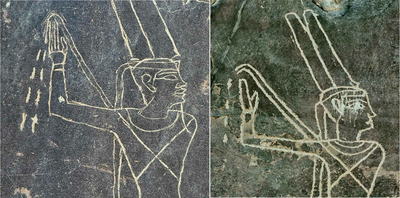
23.31 The Flail is all about projected water and with a directional arrow
Because the impactor is moving onto wooden boards covered with water to reduce the friction, water is violently pushed forward in front of Apis' front hooves : both hooves are pushing the snake's body forward. But water is also projected backwards, creating fabulous plumes of water in the path of the speeding impactor : the flail is these plumes of water, and if it looks "broken", it is only an artistic rendering of the idea of water projected backwards. The flail is exactly like a directional arrow, pointing towards where the water is coming from and in which direction it is projected to.
Relief at Wadi Hammamat showing that the flail symbol is all about water. Middle Kingdom Dynasty 11, Nebhepetre Mentuhotep II. Photographed by kairoinfo4u: https://www.flickr.com/photos/manna4u/25932728632/in/photostream/
Stone relief at Wadi Hammamat, Dynasty 17 by kairoinfo4u: https://www.flickr.com/photos/manna4u/25999304796/in/photostream/
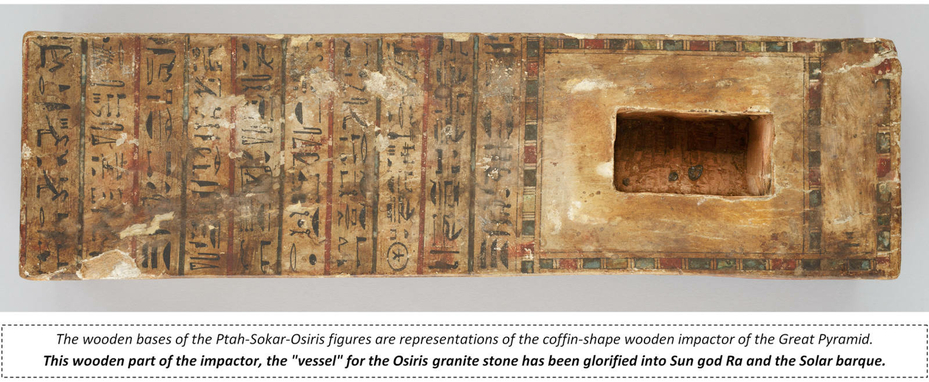
Wooden coffin-shape base of a Ptah-Sokar-Osiris figure, at the Metropolitan Museum of Art, New-York. Dedicated to a temple musician named Ihet, it is inscribed with offering prayers and texts glorifying the gods: https://www.metmuseum.org/art/collection/search/553823
23.32 The wooden coffin made to fit Osiris exactly and thrown into the Nile
We've already seen in the Osiris myth (Section 21), that Osiris was the granite stone lodged inside the wooden impactor of the Great Pyramid :
"In the Osiris myth, Osiris was killed by Set by being tricked into a coffin made to fit Osiris exactly. Set then had the coffin with the now deceased Osiris flung into the Nile." https://en.wikipedia.org/wiki/Djed
In this excerpt, the mention of the Nile is of course referring to the waters of the inclined well which were indeed waters from the Nile. In some ways, the impactor was thrown into 'the Nile'.
On the above image of a Ptah-Sokar-Osiris figure at the MET, what is interesting to note is not really the hollowed cavity in which the human figure is normally inserted in, but the area all around this cavity : if there is no hieroglyphic text all around the cavity in a perfect rectangular shape, it is because what really is depicted is the original shape of the Osiris stone cavity
23.33 The "sacred chest containing a small golden coffer" in Osiris' worship are replicating the impactor's design
It is mentioned that, in honor of Osiris, "ceremonies were performed inside the temples by priests. Plutarch mentions that […] two days after the beginning of the festival "the priests bring forth a sacred chest containing a small golden coffer". https://en.wikipedia.org/wiki/Osiris
The sacred chest containing a small golden coffin is the representation of the impactor containing the Osiris stone.
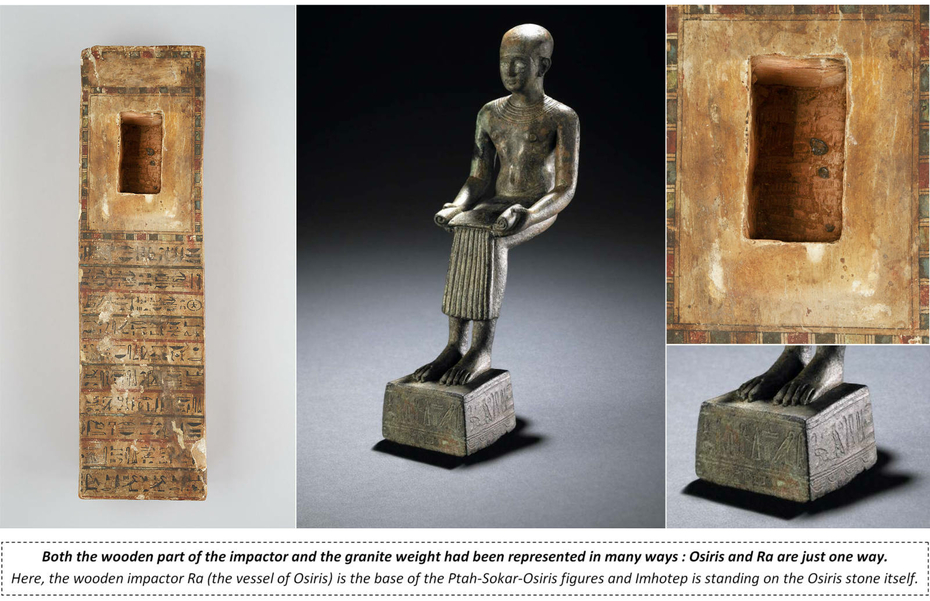
Bronze seated figure of Imhotep at the British Museum: https://www.britishmuseum.org/collection/object/Y_EA40666
23.34 The boat race and the dual wooden and stone composite design of the impactor
The inspiration of the boat race in the next excerpt is clearly the dual composite design of the impactor, both in wood and in stone. Most probably the stone is made of granite, as this rock is the most valuable and the most shock resistant.
"… the other gods were getting tired from over eighty years of fighting and challenges. Horus and Set challenged each other to a boat race, where they each raced in a boat made of stone. Horus and Set agreed, and the race started. But Horus had an edge: his boat was made of wood painted to resemble stone, rather than true stone. Set's boat, being made of heavy stone, sank, but Horus' did not. Horus then won the race, and Set stepped down and officially gave Horus the throne of Egypt." https://en.wikipedia.org/wiki/Horus
We'll talk later on about these 80 years of 'challenge' in paragraph 23.34
23.35 The 'creator of everything' god Ra
I really got confused about Sun god Ra, because of his Solar barque. I knew that this barque, the Solar boat or Solar barge was representing the endless cycle of the impactor's operation inside the Grand Gallery, but I've always wondered who really was Ra representing himself; until I realized that they was no such thing as Ra and his Solar barque: Ra is the barque. Ra is the impactor, the one piece of equipment of the Great Pyramid that pressurized the inclined well and the one piece of equipment that created the evaporative cold, because of the power of the Osiris stone.
In other words, Ra was the primary god who created everything :
"Ra (Re) was the primary name of the sun god of Ancient Egypt. He was often considered to be the King of the Gods and thus the patron of the pharaoh and one of the central gods of the Egyptian pantheon. He was also described as the creator of everything." https://ancientegyptonline.co.uk/ra/
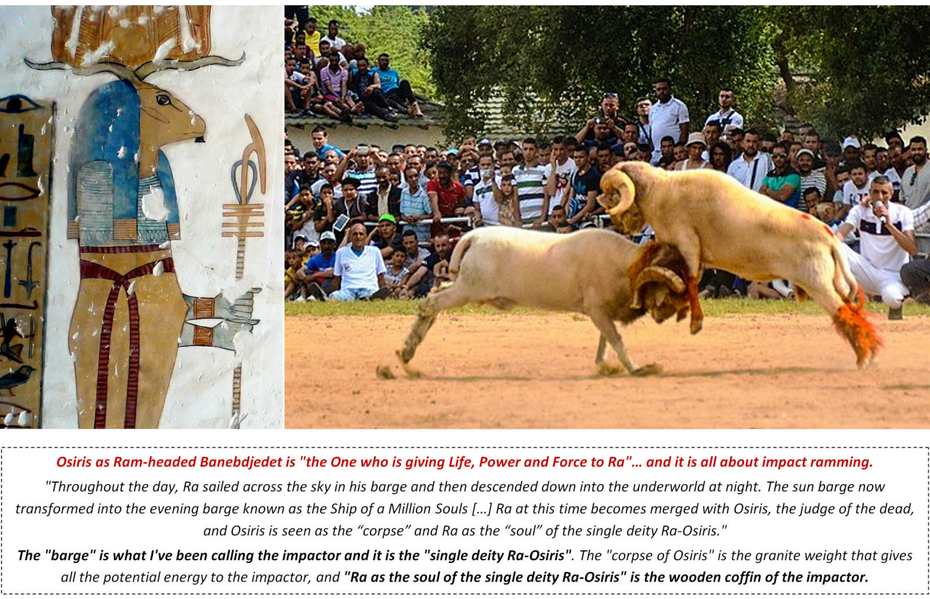
Banebdjedet wielding a scepter of the Was-sceptre, Djed, and Ankh. From the Tomb of Mentuherkhepeshef in the Valley of the Kings. Photograph thanks to kairoinfo4u: https://www.flickr.com/photos/manna4u/3331554556/in/photostream/
23.36 Osiris as Ram-headed Banebdjedet is the one who is giving life, power and force to Ra
The idea that Osiris (i.e. the granite stone weight), 'merged' with Ra in the Underworld (i.e. who was inserted into Ra, the impactor), and that it is him, Osiris who actually gave all his force and power to Sun god Ra (i.e.his potential energy), is actually perfectly depicted into Banebdjed, the soul of Osiris, or rather his Ba which had been associated with the ram.
And there is the ramming metaphor I've been using all along. The power of Ra comes from the power of Osiris, and it is about the force and the power of a ram : both Ra and Osiris were ramming into the inclined well waters.
"Osiris' soul, or rather his Ba, was occasionally worshipped in its own right, almost as if it were a distinct god […] This aspect of Osiris was referred to as Banebdjedet. […] As Banebdjed, Osiris was given epithets such as Lord of the Sky and Life of the (sun god) Ra."
"Ba does not mean "soul" in the western sense, and has to do with power, reputation, force of character, especially in the case of a god. Since the ba was associated with power, and also happened to be a word for ram in Egyptian, Banebdjed was depicted as a ram, or as Ram-headed." Osiris "Ram god": https://en.wikipedia.org/wiki/Osiris
Ram fighting on Wikimedia Commons thanks to Brahim Djelloul Mustapha: https://commons.wikimedia.org/wiki/Category:Ram_fighting

Le réveil d'Osiris (the Awakening of Osiris) at the Exposition Osiris, Institut du Monde Arabe, by Denis and Gautier Poupeau
Skeleton infographic by the International Bobsleigh and Skeleton Federation: https://www.ibsf.org/en/our-sports/skeleton-info-graphics
23.37 The force and power that Osiris is giving to Ra is all about his high-speed 'skeleton position'
If you don't know what really was representing Osiris, there is very little chance that you can understand his 'awakening' face-down and head-first riding position. But if you know that Osiris was a metaphoric glorification of the stone weight that was giving speed and energy to Ra, the impactor that was ramming into the inclined well of the Great Pyramid, then you can understand his very peculiar 'skeleton position' and why he also has rams' horns.
The Osiris granite weight was the one which gave speed and energy to the wooden impactor, but this Osiris stone couldn't have been operated without the wooden impactor : there had to be a 'vessel' for the Osiris stone. The wooden impactor, Ra was this vessel.
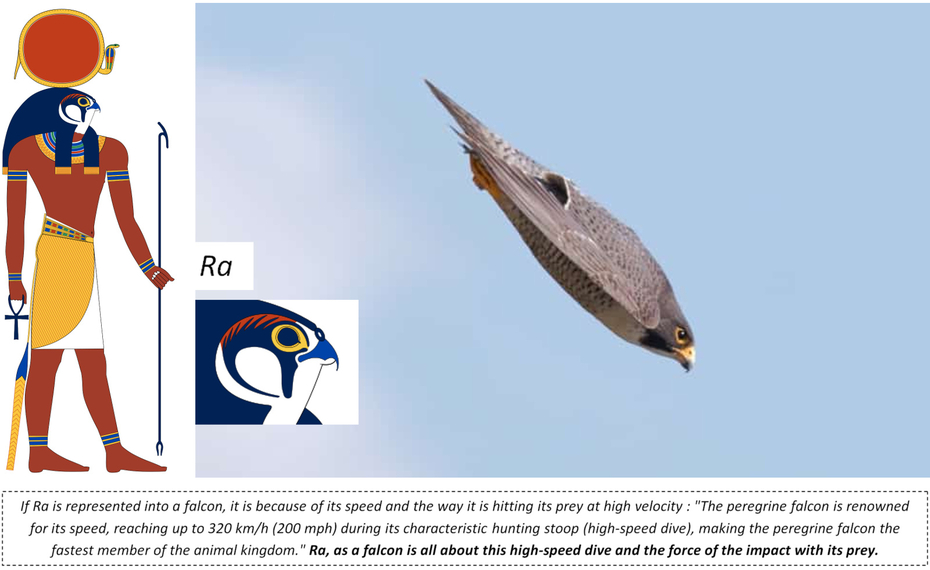
If Ra is represented into a falcon, it is because of its speed and the way it is hitting its prey at high velocity : "The peregrine falcon is renowned for its speed, reaching up to 320 km/h (200 mph) during its characteristic hunting stoop (high-speed dive), making the peregrine falcon the fastest member of the animal kingdom." Ra, as a falcon is all about this high-speed dive and the force of the impact with its prey. https://en.wikipedia.org/wiki/Peregrine_falcon
Ra-Horakhty is a combined deity of Horus and Ra, and is usually depicted as a falcon-headed man. Draw by Jeff Dahl: https://en.wikipedia.org/wiki/Ra#/media/File:Re-Horakhty.svg
Photograph of a high-speed diving falcon by Lassannn, on imgur and also at https://www.facebook.com/wildlifeatrisk/photos/a.442972959170883/1593597324108435/
23.38 The high-speed that Osiris is giving to Ra is all about the force of impact ramming
If Ra is represented into a falcon, it is because of its high speed and the way it is hitting its prey at high velocity : "The peregrine falcon is renowned for its speed, reaching up to 320 km/h (200 mph) during its characteristic hunting stoop (high-speed dive), making the peregrine falcon the fastest member of the animal kingdom."
Ra, as a falcon is all about this high-speed dive and the force of the impact with its prey. The below images are coming from a video where a prairie falcon is hitting a duck at about 90 km/h. On the right image, the falcon is long gone but the duck is already dead : the impact alone killed it.

Prairie falcons are famous for their hard-hitting hunting tactics. Here a wild juvenile female finishes off a drake mallard with a high-speed headshot. Analysis of the video tells us she's moving close to 90km/h when she hits the mallard. Prairie falcons frequently employ this hunting method when dealing with field-feeding waterfowl. The duck is heavier and stronger, therefore the ground struggle is minimized when the smaller falcon delivers a knockout punch. Screenshots from a video posted by falcorusticolus77 on YouTube (contains shocking images): https://www.youtube.com/watch?v=73OvZ_l35Sw
23.39 The impactor ramming into the inclined well waters (Nun) to produce pressurized water (Apep)
I've already talked about the distinction that has to be made between the waters of the well before the pressurization and the pressurized waters strictly speaking.
The 'plain still' waters had been glorified into what have been called the primordial waters of Nun, while the pressurized waters had been represented into the Great Serpent Apep (also Apophis).
"At the beginning of time, when there was nothing but chaos, the sun-god existed alone in the watery mass of Nun which filled the universe. "I am Atum when he was alone in Nun, I am Ra when he dawned, when he began to rule that which he had made. This passage talks about how Atum created everything in human form out of the chaos."
Once the well is pressurized, a small amount of that water is ejected into the horizontal cooling passage, and that is Atum : about 200 liters of pressurized water which every 15 minutes or so passes through the fog nozzle to create a fog of microdroplets of liquid water. This very particular form of water had been glorified into goddess Tefnut (Tef, or 'tf', meaning to spit, Section 5).
"He (Ra) created Shu, god of air, and the goddess of moisture, Tefnut." https://en.wikipedia.org/wiki/Ra
The above excerpt is by the way, another confirmation that the purpose of the impactor was not limited to produce pressurized water, just like the "awakening" Osiris figure already have suggested it (previous Section 21).
If Ra is the one creating Shu, the god of dry and warm air, it is because the fall of the impactor is taking place inside a fixed wooden caisson that was perfectly extending the inclined well, probably to the top of the Grand Gallery.
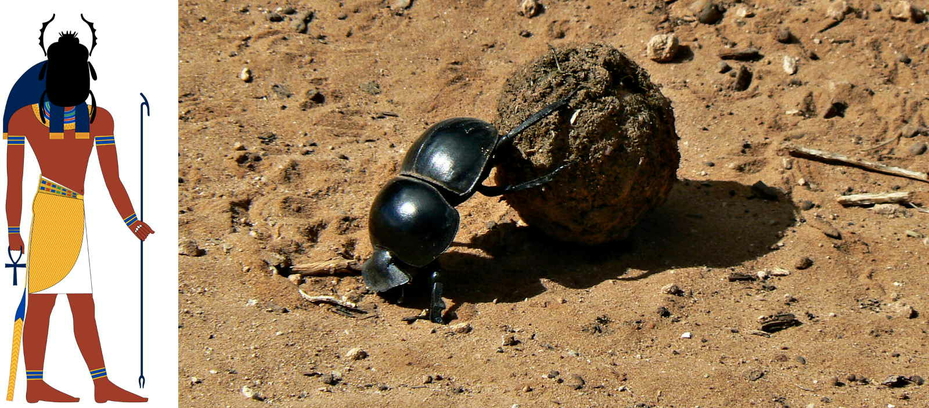
Khepri, an ancient Egyptian deity often represented with the head of a beetle. Based on New Kingdom tomb paintings and drawn by Jeff Dahl: https://en.wikipedia.org/wiki/Khepri
Image of the dung beetle, thanks to Kay-africa
23.40 The reattachment of the impactor with the Hauling Beetle "at the twelfth hour"
In the day and night metaphoric representation of the operating cycle of the impactor, it is interesting to note that at the twelfth hour, Ra is "reborn as the scarab Khepri" : this is the beginning of a new cycle of Hauling and releasing the impactor.
And this is amazing, because not only it is the description of the impactor being retrieved from the waters of the well, but it is also describing its reattachment with the Hauling Beetle.
When I started to call the Hauling gantry, the Hauling "Beetle" it was only because it would have move backwards down the Grand Gallery, like a scarab does when he is pushing his dung ball; but here this is the confirmation that the Scarab amulets are representations of that Hauling gantry.
"The worship of the Egyptian God Ra was at its peak during the New Kingdom. Many of the tombs in the Valley of the Kings (dating from this period) included depictions of Ra’s journey through the underworld over twelve “hours” or stages. In the fifth hour, Ra dies and is reunited with Osiris in the underworld, but in the twelfth hour he is reborn as the scarab (Khepri)." https://ancientegyptonline.co.uk/ra/
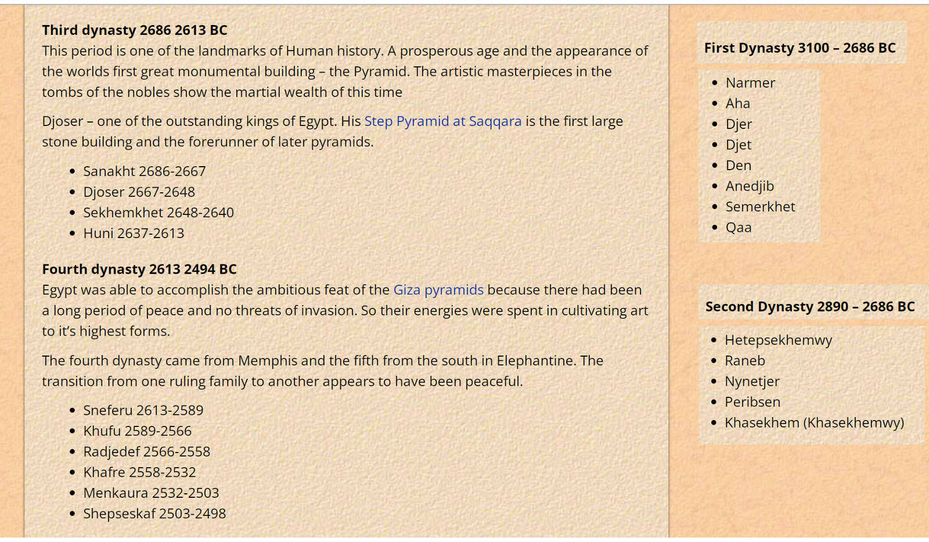
Egyptian Old Kingdom Dynasties: https://discoveringegypt.com/ancient-egyptian-kings-queens/egyptian-old-kingdom-dynasties/
23.41 The 80 years of mythological trials vs. the 78 years of the great pyramids Era (Djoser to Khufu)
One of the most interesting question that would have to be resolved in the future, will be to determine, as much as possible, whose pharaoh was responsible for every step of scientific and technological discoveries which ended up with the masterpiece of engineering that is the Great Pyramid of Giza.
We can assume that it all started with the very first Dynasty, but it is legitimate to say that everything could really have gotten serious with pharaoh Djoser, from the Third Dynasty, and the construction of the first real pyramid, the Step Pyramid.
Djoser would be the pharaoh who started the most ambitious technological research program since the beginning of what we can call the Engineer Pharaohs' Era; and probably what triggered this acceleration in the research could have been the quest for the mastering of the Solvay process for natron manufacturing.
But, the one pharaoh who really massively invested in the program was Sneferu with his 3 pyramids. Most probably, Sneferu is the one who also ended the research phase, and it is logical to imagine that it also was the end of his own reign around 2589 B.C.E.
Djoser's reign and the first pyramid started around 2667 B.C.E and Sneferu's reign ended up around 2589 B.C.E. That would be 78 years of research, that would have most probably been dedicated to the Solvay process alone.
Amazingly, there is a myth about Horus and Set, that is referring to 80 years of conflict, and 80 years of trials : "These contests go on for over 80 years and Ra continues to deny Horus his right to the throne […] In another version of the story, the trial lasts for 80 years until the frustrated gods turn to the wise goddess Neith, mediator of disputes, who rules in favor of Horus." https://www.worldhistory.org/Horus/
What are the chances that these 80 years of trials are or aren't referring to this 78 years of Egypt history from the beginning of Djoser's reign to the end of Sneferu's? Go figure…
But this would be a formidable confirmation that the Great Pyramid was just the next step : Sneferu finished the research program on the Solvay process, and Khufu would have taken over to put everything together in one single gigantic pyramid where the Solvay chambers would have been finally efficiently cooled down; exactly what couldn't have been achieved in the Red Pyramid (Section 14 and 15).
Of course, if we are interested in the total duration of the Engineer Pharaoh's Era, it would be 534 years from the beginning of Dynasty I, to the end of Khufu's reign (3100 B.C.E. to 2566 B.C.E.).
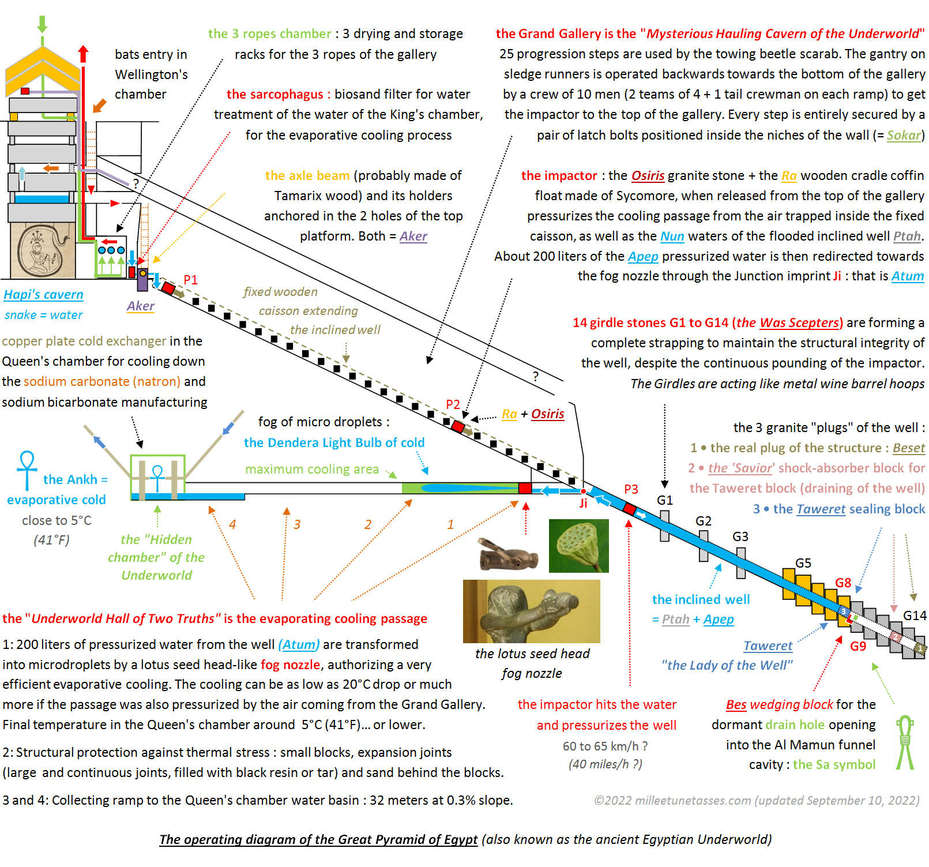
Diagram of the Great Pyramid of Egypt in operation for evaporative cold production, most probably for industrial cooling of Solvay process manufacturing of sodium carbonate (natron) and sodium bicarbonate
23.42 Summary of the study: hidden behind the academic vision of the ancient Egyptian religion, a vast number of metaphors are describing some of the most advanced science and technological knowledge of that time : ancient Egyptian gods were nothing else than pharaohs' metaphoric self-glorifications of their theoretical and experimental scientific accomplishments in physics and chemistry.
Pharaohs used the power of Science to legitimate themselves as kings of Egypt : they forged an entire religion, based on science to rule their kingdom, and they presented that science as Magic.
The end game of this technological program that probably started on the very first Dynasty, was the Great Pyramid of Giza where evaporative cooling was engineered in the known part of the pyramid from the pressurized water produced in the inclined well, known today as the ascending passage.
The evaporative cold simply took advantage of the power of water, and was most probably necessary to cool down chemical manufacturing of sodium carbonate and sodium bicarbonate produced by an ammonia-soda Solvay process, as suggested by the very strong ammonia smell and the limestone kiln in the so-called burial chamber of the Red Pyramid. At that time, sodium carbonate was called natron, and it was the salt used for the mummification of the pharaohs (Sections 14, 15 and 16).
The cooling seems to have represented the most difficult part of the process, as suggested by the Step Pyramid's official name : according to scholars, the very first pyramid complex, the Step Pyramid of Djoser, was called "the refreshment of the Gods". No doubt that a more accurate translation would certainly be "the cooling of the Gods".
It means that ancient Egyptians were the first civilization to master a Solvay-like process for sodium carbonate manufacturing, long before it got reinvented in the 1800's in Europe. The key elements of that process is the temperature control of the chemical reactions (the cooling), and the dome shaped plate necessary for the counterflow chemical reactions to occur in an efficient way. That counterflow reaction plate is what really is the disc of Sabu.
As shown with Akhenaten and Nefertiti, the creation of the evaporative cold was the most sacred accomplishment of all (Section 17), and this is exactly what the Dendera Light is all about : the Dendera Light is the fog of microdroplets of liquid water that evaporates and creates the cold. Talking about the snake inside the Dendera Light Bulb : "The field surrounding Ra’s snake form is referred to in ancient Egyptian literature as protective magical energy in liquid form that all gods and pharaohs possess" (Faulkner, Section 2).
Everything that had been done in the Great Pyramid of Giza inspired most of the ancient Egyptian religion, and it had been glorified into what we know today as the Underworld.
The Underworld is referring to the chambers and passages of the Great Pyramid of Khufu, and in particular to the Grand Gallery where a hauling gantry beetle operated a wooden coffin shaped impactor that had a small nested granite block inside it. The impactor generated endlessly, over and over, maybe every 15 minutes the pressurized water that was then transformed into a fog of microdroplets inside the horizontal cooling passage.
The Grand Gallery of the Great Pyramid where the act of hauling was done, is the "Secret Hauling Cavern of the Underworld" described in the Amduat "Book of the Hidden Chamber".
The most important chamber of the Great Pyramid wasn't the King's chamber that only was the main water tank of the pyramid, but the Queen's chamber, the only one on the central axis of the pyramid. Because the Queen's chamber was inaccessible from the rest of the pyramid, it was glorified into the "Hidden Chamber of the Underworld" (Section 11), and because the Queen's chamber was the coolest place in the pyramid (about 5°C / 41°F), and with a constant 100% Humidity rate, this chamber was the one where the biggest amount of very hard salt encrustation had been documented by the first explorers of the pyramid in the 1800's and before it had been removed in 1998 by Zahi Hawass (Section 1). Very hard salt encrustation is the signature of the evaporative cooling process, even nowadays.
The most incredible thing is that pretty much everything I've just said, actually appears in many myths, and they don't even originate from ancient Egypt : the "Churning of the Ocean" Hindu myth that produces the immortal nectar Amrita, the Tibetan Prayer Wheels operated to give small amounts of 'merit' to too lazy Naga snakes, and the entire Norse mythology with Thor's magical hammer endlessly fighting another Great Serpent of the Underworld and producing a mist of cold from a mysterious well that would be opposed to hellishly hot heat waves.
I'm talking a lot about the impactor of the Great Pyramid, but it is nothing compared to the tremendous impact caused by what the ancient Egyptians had accomplished within the 78 years of the Great Pyramids Era, from Djoser to the Great Pyramid: the entire ancient World had been shaken up in their deepest beliefs beyond all comprehension; and we are still talking about it today.
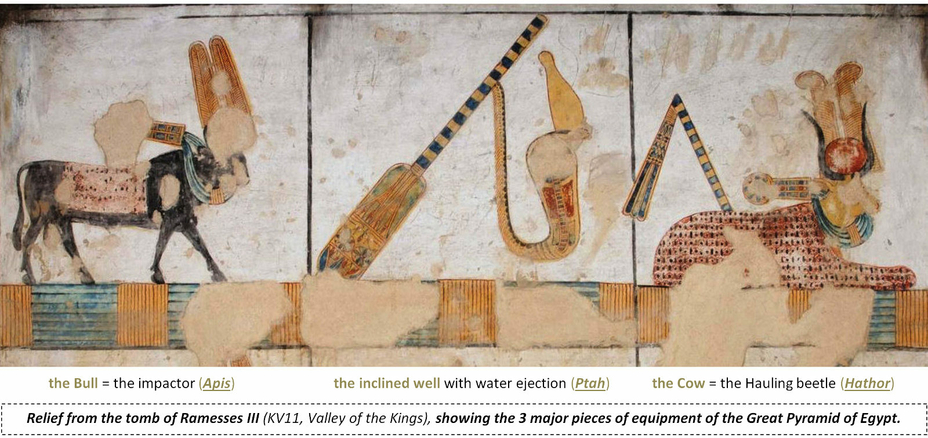
Detail of an image from the ARCE (American Research Center in Egypt in partnership with the American University in Cairo Egyptology Department), in the tomb of Rameses III, KV 11: side chamber, right wall. Valley of the Kings, East Valley, West Bank, Luxor. Image #21077 by Matjaz Kacicnik, taken on December 2005 : https://thebanmappingproject.com/index.php/images/21077jpg
23.43 Ptah the patron of craftsmen and architects because of the inclined well design
As the representation of the inclined well of the Great Pyramid, the creator god Ptah has been identified with the patron of craftsmen and architects.
The well was the most advanced piece of equipment ever built, in some ways it could be compared to a modern engine cylinder, and the impactor to the piston of that engine. The structural integrity of the well was ensured by the 14 Girdle stones that probably are the biggest blocks of the pyramid, even bigger than the top platform of the Grand Gallery.
But this particular aspect of the engineering of the well was minor : there are only 3 girdles in the upper part of the well; and the impactor certainly didn't go much farther down.
All the other face to face Girdles at the bottom of the well were only there to ensure that the draining of the well wouldn't be jeopardized by the constraints supported by the structure. This part can be compared to modern reinforced concrete : nothing could have been allowed to move even an inch so that the Taweret block could free the drain hole. The Taweret block absolutely needed to slide freely towards the 'Savior' shock absorber granite plug #2.
Please, take just one minute to imagine the whole thing : the Bes block had to break under a precise amount of pressure to let the Taweret block slide with the water… then the tremendous sound when Taweret hits the Savior block… and the sound of all that water gushing out of the well into the Al-Ma'mun cavity.
No wonder Ptah had been identified with the patron of craftsmen and architects and was linked with Imhotep, sometimes himself represented on the Osiris' stone weight.
"Ptah (Ancient Egyptian: pth) is an ancient Egyptian deity, a creator god and patron of craftsmen and architects. In the triad of Memphis, he is the husband of Sekhmet and the father of Nefertem. He was also regarded as the father of the sage Imhotep."

Statue of god Ptah, photographed by kairoinfo4u: https://www.flickr.com/photos/manna4u/26774477850/in/photostream/
"Ptah, in the form of a mummified man (except for arms and face) standing on the symbol for Ma'at, holding a scepter or staff that bears the combined ankh-djed-was symbols" and drawing of the Creation god Ptah by Jeff Dahl on Wikipedia: https://en.wikipedia.org/wiki/Ptah
Photograph from tomb KV 11 of Ramesses III, side chamber, image # 21076 by Matjaz Kacicnik, courtesy of ARCE, American Research Center in Egypt in partnership with the American University in Cairo Egyptology Department: https://thebanmappingproject.com/images/21076jpg
More on the ancient Egyptian god of Creation Ptah, in previous Sections 21 (Tibetan Prayer Wheels) and Section 22 (Thor and Norse mythology)
23.44 Ptah's hollow scepter is the inclined well representation
In the above image and in most of his representations, Ptah is holding a blue and yellow scepter or staff that bears the combined ankh, djed and was symbols.
This blue and yellow 'staff' is actually the representation of the inclined well of the pyramid, and the reason why the ankh, djed and was symbols seem to be nested into that 'staff' is only to indicate that it is hollow : the 'staff' is the inclined well and the dotted blue line is about the movement of water .
The representation of the well held by Ptah is always in a perfect vertical position, but its true nature is shown in the tomb of Ramesses III : it has pretty much the same slope than the Grand Gallery/ascending passage layout.
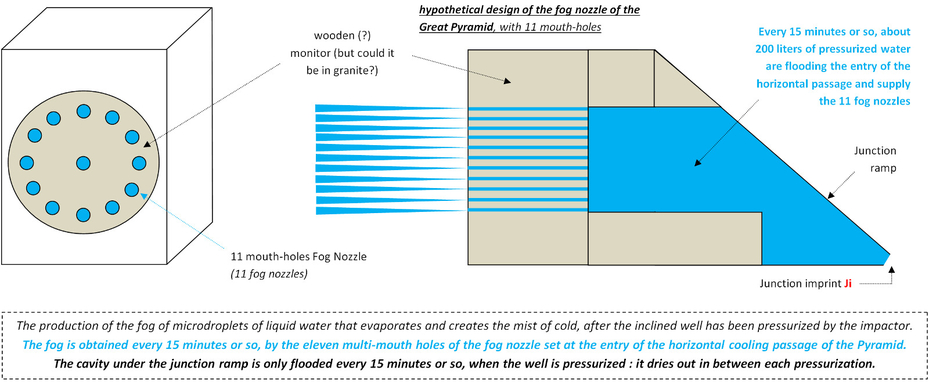
23.45 The design of the fog nozzle of the Great Pyramid of Egypt
First suggestion of the design of the eleven mouth-holes fog nozzle of the Great Pyramid of Egypt, based on the eleven rivers from the well of Élivágar of the Norse mythology.

The ancient Egyptian Shabaka Stone which record the 'Memphite Theology' or creation myth, a text perhaps originally composed during the New Kingdom, in which Ptah is responsible for the creation of all things by means of the spoken word. The Shabaka Stone at the British Museum: https://www.britishmuseum.org/collection/object/Y_EA498
23.46 The ancient Egyptian Shabaka stone and the 11 lines
It really has to be pointed out that when ancient Egyptians used the term "creation", it isn't referring to the creation of the world. "Creation" is about the evaporative cold, created from the primordial waters of Nun, the waters of the well.
It means that creator god Ptah is about this creation of the cold, and that the Shabaka stone is also referring to that creation; if there are 11 lines separated from the central rectangular shape, it also has to refer to that creation.

23.47 Norse mythology vs. the operating of the Great Pyramid of Egypt
Everything in Norse mythology is a complete reinterpretation of the operating of the Great Pyramid of Egypt (previous Section 22).
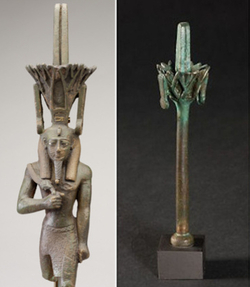
23.48 The limits of the fog nozzle with 11 mouth-holes hypothesis
I strongly have to point out that the hypothesis of an eleven mouth-holes fog nozzle is clearly highly questionable, because it is only coming from the Norse Eleven Rivers coming out of the Well of Hvergelmir that are creating the mist of cold in Niflheim.
Anyway, the idea of flooding entirely the space at the entry of the ascending passage, just below the junction ramp Grand Gallery/Ascending Passage, could be a solid hypothesis, even it would rule out the idea of a central pipe, as represented on the Nefertem emblems at the Louvre Museum.
Nefertum at the Metropolitan Museum of Art, New-York: https://www.metmuseum.org/art/collection/search/551300
Nefertem Emblem, inventory number N 5118 © Musée du Louvre / Christian Décamps: https://collections.louvre.fr/ark:/53355/cl010008518
Poster un commentaire

